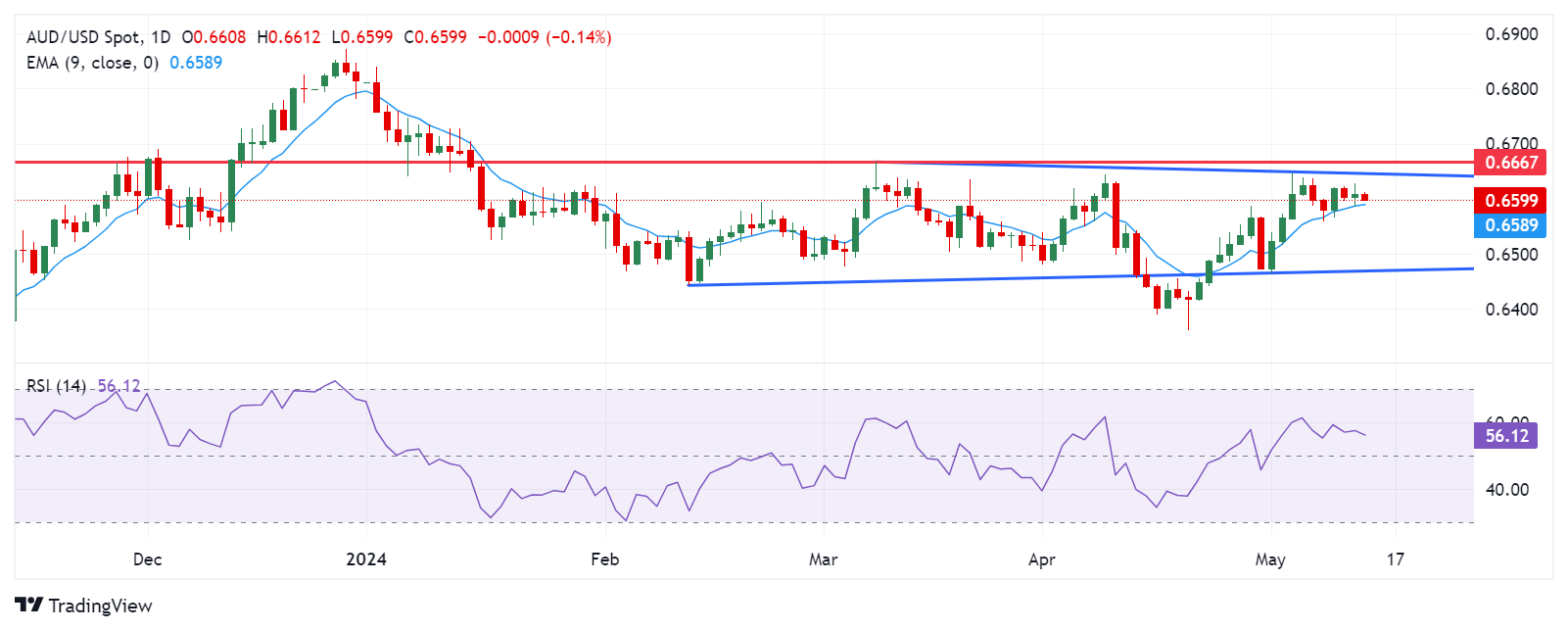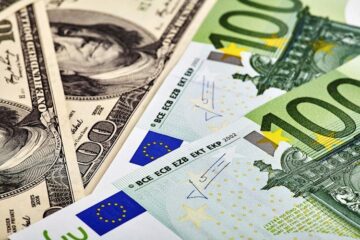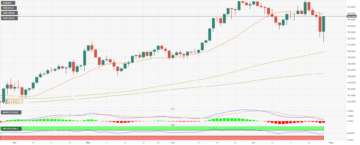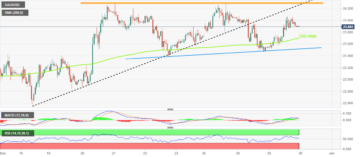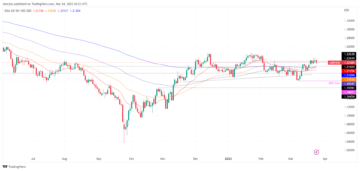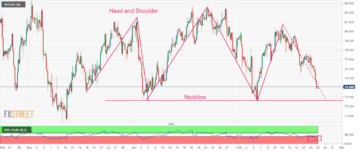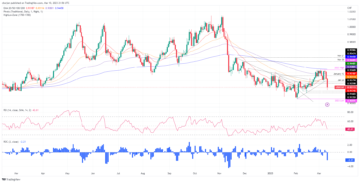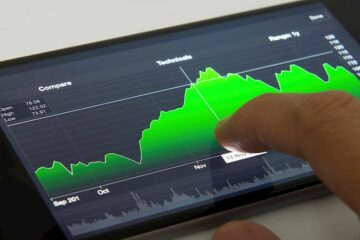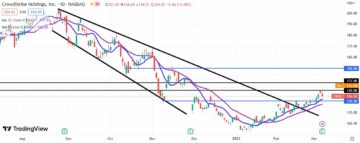- The Australian Dollar received pressure due to the dovish RBA.
- Australia’s Treasury predicted that CPI inflation would decrease to 3.75% by mid-2024.
- The US Dollar remains firmer as Fed officials indicated to maintain higher rates for longer.
The Australian Dollar (AUD) retraces its recent gains on Tuesday ahead of the Yearly Budget Release by the Australian Government due to be published later in the day. Treasurer Jim Chalmers hinted at positive developments during Sunday morning television interviews, suggesting that the upcoming budget could show a faster decline in inflation than the Reserve Bank of Australia (RBA) had predicted, as reported by The Guardian.
The Australian Dollar received pressure following the RBA’s less hawkish stance after opting to maintain its interest rate at 4.35% last week. Speculation had been rife in the markets that the central bank might lean toward a more hawkish position, spurred by recent inflation data surpassing expectations.
The US Dollar Index (DXY), which gauges the performance of the US Dollar (USD) against six major currencies, gains ground due to cautious remarks from Federal Reserve (Fed) officials, highlighting the necessity of maintaining higher rates for an extended period as inflation remains elevated. Fed Vice Chair Philip Jefferson echoed this sentiment on Monday, advocating for the retention of current interest rates until signs of inflation easing become more apparent.
On Tuesday, investors are expected to closely monitor the crucial economic indicator, the Producer Price Index (PPI), which could serve as a significant market catalyst. Traders may utilize the PPI report to gauge the potential outcome of the Consumer Price Index (CPI), and if the data turns out to be higher than expected, it could further bolster the US Dollar.
Daily Digest Market Movers: Australian Dollar edges lower due to a dovish RBA
- National Australia Bank’s Business Conditions fell to 7 in April, from the previous reading of 9. Meanwhile, National Australia Bank’s Business Confidence stood at the reading of 1.
- Australia’s Treasury announced on Sunday that they forecasted that inflation could re-enter the Reserve Bank of Australia’s (RBA) target range by the end of 2024. In their December outlook, officials predicted that CPI inflation would decrease to 3.75% by mid-2024 and 2.75% by mid-2025, aligning it with the RBA’s target range.
- Federal Reserve Bank of New York conducted a consumer sentiment survey, indicating that US consumers anticipate a broad acceleration in inflation over the next year, with expectations reaching 3.3%. This marks an increase from the 3.0% figure reported in March for consumer one-year inflation expectations.
- According to Reuters, Neel Kashkari, President of the Minneapolis Federal Reserve (Fed), expressed caution regarding the level of restrictiveness in monetary policy. On Friday, Kashkari stated in an interview with CNBC that while the threshold for another rate hike is high, it cannot be entirely ruled out. Additionally, San Francisco Fed President Mary Daly emphasized the necessity of maintaining a prolonged restrictive policy to attain the Federal Reserve’s inflation objectives.
- On Friday, the University of Michigan Consumer Sentiment Index, dropped to 67.4 in May from April’s 77.2, marking a six-month low and falling short of market expectations of 76 reading. Meanwhile, the UoM 5-year Consumer Inflation Expectation rose to 3.1%, a six-month high, up from 3.0% prior.
- The Commonwealth Bank of Australia (CBA) has revised down its forecasts for the Australian Dollar at the end of 2024 is 0.69, down from 0.71 previously. CBA cites factors such as the interest rate gap and elevated US Treasury bond yields, which are bolstering the US Dollar. The Federal Reserve’s cautious stance on high inflation and its reluctance to implement rate cuts further support the US Dollar, as reported on forexlive.com.
Technical Analysis: Australian Dollar maintains its position near the major level of 0.6600
The Australian Dollar trades around 0.6600 on Monday. The AUD/USD pair consolidates within a symmetrical triangle pattern. Additionally, the 14-day Relative Strength Index (RSI) suggests a bullish inclination as it remains above the 50 level.
Potential movements indicate that the AUD/USD pair may challenge the upper boundary near the swing area at 0.6650. A breakthrough above this level could lead to a retest of March’s high at 0.6667, with further upward momentum possibly targeting the psychological threshold of 0.6700.
Conversely, immediate support is foreseen around the 14-day Exponential Moving Average (EMA) at 0.6569. If the pair breaches below this EMA, it might face additional selling pressure, potentially descending towards the region around the lower boundary of the symmetrical triangle, approximately at 0.6465.
AUD/USD: Daily Chart
Australian Dollar price today
The table below shows the percentage change of the Australian Dollar (AUD) against listed major currencies today. The Australian Dollar was the weakest against the US Dollar.
| USD | EUR | GBP | CAD | AUD | JPY | NZD | CHF | |
| USD | 0.05% | 0.03% | 0.07% | 0.09% | 0.10% | 0.13% | 0.02% | |
| EUR | -0.06% | -0.02% | 0.02% | 0.04% | 0.07% | 0.09% | -0.01% | |
| GBP | -0.03% | 0.02% | 0.04% | 0.09% | 0.08% | 0.11% | 0.01% | |
| CAD | -0.07% | -0.03% | -0.06% | 0.04% | 0.04% | 0.06% | -0.03% | |
| AUD | -0.13% | -0.07% | -0.08% | -0.04% | 0.00% | 0.02% | -0.08% | |
| JPY | -0.10% | -0.05% | -0.08% | -0.04% | -0.01% | 0.02% | -0.07% | |
| NZD | -0.13% | -0.06% | -0.08% | -0.06% | -0.02% | -0.01% | -0.09% | |
| CHF | -0.05% | 0.00% | -0.01% | 0.03% | 0.07% | 0.07% | 0.09% |
The heat map shows percentage changes of major currencies against each other. The base currency is picked from the left column, while the quote currency is picked from the top row. For example, if you pick the Euro from the left column and move along the horizontal line to the Japanese Yen, the percentage change displayed in the box will represent EUR (base)/JPY (quote).
Australian Dollar FAQs
One of the most significant factors for the Australian Dollar (AUD) is the level of interest rates set by the Reserve Bank of Australia (RBA). Because Australia is a resource-rich country another key driver is the price of its biggest export, Iron Ore. The health of the Chinese economy, its largest trading partner, is a factor, as well as inflation in Australia, its growth rate, and Trade Balance. Market sentiment – whether investors are taking on more risky assets (risk-on) or seeking safe havens (risk-off) – is also a factor, with risk-on positive for AUD.
The Reserve Bank of Australia (RBA) influences the Australian Dollar (AUD) by setting the level of interest rates that Australian banks can lend to each other. This influences the level of interest rates in the economy as a whole. The main goal of the RBA is to maintain a stable inflation rate of 2-3% by adjusting interest rates up or down. Relatively high interest rates compared to other major central banks support the AUD, and the opposite for relatively low. The RBA can also use quantitative easing and tightening to influence credit conditions, with the former AUD-negative and the latter AUD-positive.
China is Australia’s largest trading partner so the health of the Chinese economy is a major influence on the value of the Australian Dollar (AUD). When the Chinese economy is doing well it purchases more raw materials, goods and services from Australia, lifting demand for the AUD, and pushing up its value. The opposite is the case when the Chinese economy is not growing as fast as expected. Positive or negative surprises in Chinese growth data, therefore, often have a direct impact on the Australian Dollar and its pairs.
Iron Ore is Australia’s largest export, accounting for $118 billion a year according to data from 2021, with China as its primary destination. The price of Iron Ore, therefore, can be a driver of the Australian Dollar. Generally, if the price of Iron Ore rises, AUD also goes up, as aggregate demand for the currency increases. The opposite is the case if the price of Iron Ore falls. Higher Iron Ore prices also tend to result in a greater likelihood of a positive Trade Balance for Australia, which is also positive of the AUD.
The Trade Balance, which is the difference between what a country earns from its exports versus what it pays for its imports, is another factor that can influence the value of the Australian Dollar. If Australia produces highly sought after exports, then its currency will gain in value purely from the surplus demand created from foreign buyers seeking to purchase its exports versus what it spends to purchase imports. Therefore, a positive net Trade Balance strengthens the AUD, with the opposite effect if the Trade Balance is negative.
- SEO Powered Content & PR Distribution. Get Amplified Today.
- PlatoData.Network Vertical Generative Ai. Empower Yourself. Access Here.
- PlatoAiStream. Web3 Intelligence. Knowledge Amplified. Access Here.
- PlatoESG. Carbon, CleanTech, Energy, Environment, Solar, Waste Management. Access Here.
- PlatoHealth. Biotech and Clinical Trials Intelligence. Access Here.
- Source: https://www.fxstreet.com/news/australian-dollar-depreciates-ahead-of-the-australian-budget-release-202405140157
- :has
- :is
- :not
- $UP
- 1
- 10
- 12
- 13
- 2%
- 2021
- 2024
- 31
- 35%
- 4
- 41
- 50
- 6600
- 67
- 69
- 7
- 77
- 9
- a
- above
- acceleration
- According
- Accounting
- Additional
- Additionally
- adjusting
- advocating
- After
- against
- aggregate
- ahead
- aligning
- along
- also
- an
- analysis
- and
- announced
- Another
- anticipate
- apparent
- approximately
- April
- ARE
- AREA
- around
- AS
- Assets
- At
- attain
- AUD
- AUD/USD
- Australia
- Australian
- Australian dollar
- average
- Balance
- Bank
- Banks
- base
- BE
- because
- become
- been
- below
- between
- Biggest
- Billion
- bolster
- bolstering
- bond
- Bond yields
- Box
- breaches
- breakthrough
- broad
- budget
- Bullish
- business
- buyers
- by
- CAN
- cannot
- case
- Catalyst
- caution
- cautious
- central
- Central Bank
- Central Banks
- Chair
- challenge
- change
- Changes
- checked
- China
- chinese
- closely
- CNBC
- Column
- COM
- commonwealth
- compared
- conditions
- conducted
- confidence
- Consolidates
- consumer
- consumer price index
- consumer sentiment
- Consumers
- could
- country
- CPI
- created
- credit
- crucial
- currencies
- Currency
- Current
- cuts
- daily
- data
- day
- December
- Decline
- decrease
- Demand
- destination
- developments
- difference
- Digest
- direct
- displayed
- doing
- Dollar
- Dovish
- down
- driver
- dropped
- due
- during
- Dxy
- each
- easing
- echoed
- Economic
- economy
- edges
- effect
- elevated
- EMA
- emphasized
- end
- ends
- entirely
- EUR
- Euro
- example
- expectation
- expectations
- expected
- exponential
- exponential moving average
- export
- exports
- expressed
- extended
- Face
- factor
- factors
- Falling
- falling short
- Falls
- FAQ
- FAST
- faster
- Fed
- Federal
- federal reserve
- Figure
- following
- For
- forecasts
- foreign
- forex
- Former
- Francisco
- Friday
- from
- from 2021
- further
- Gain
- Gains
- gap
- gauge
- generally
- goal
- Goes
- goods
- Government
- greater
- Ground
- Growing
- Growth
- guardian
- had
- Have
- Hawkish
- Health
- High
- High inflation
- higher
- highlighting
- highly
- Hike
- hinted
- Horizontal
- HTTPS
- if
- immediate
- Impact
- implement
- imports
- in
- inclination
- Increase
- Increases
- index
- indicate
- indicated
- indicating
- Indicator
- inflation
- Inflation expectations
- inflation rate
- Inflation remains elevated
- influence
- interest
- INTEREST RATE
- Interest Rates
- Interview
- Interviews
- Investors
- IT
- ITS
- Japanese
- Japanese Yen
- Jim
- Jim Chalmers
- Key
- largest
- Last
- later
- latter
- lead
- lean
- left
- LEND
- less
- Level
- lifting
- likelihood
- Line
- Listed
- longer
- Low
- lower
- Main
- maintain
- maintaining
- maintains
- major
- map
- March
- Market
- market sentiment
- Markets
- marking
- mary
- materials
- May..
- Meanwhile
- Michigan
- might
- module
- Momentum
- Monday
- Monetary
- Monetary Policy
- Monitor
- more
- morning
- most
- move
- movements
- Movers
- moving
- moving average
- National
- National Australia Bank
- Near
- necessity
- Neel Kashkari
- negative
- net
- New
- New York
- next
- objectives
- of
- officials
- often
- on
- opposite
- opting
- or
- Other
- out
- Outcome
- Outlook
- over
- pair
- pairs
- partner
- Pattern
- pays
- percentage
- performance
- period
- pick
- picked
- plato
- Plato Data Intelligence
- PlatoData
- policy
- position
- positive
- possibly
- potential
- potentially
- ppi
- predicted
- president
- pressure
- previous
- previously
- price
- Prices
- primary
- Prior
- produces
- psychological
- published
- purchase
- purchases
- purely
- Pushing
- quantitative
- Quantitative Easing
- quote
- range
- Rate
- Rate Hike
- Rates
- Raw
- RBA
- reaching
- Reading
- received
- recent
- regarding
- region
- relative
- relative strength index
- Relative Strength Index (RSI)
- relatively
- release
- reluctance
- remains
- report
- Reported
- represent
- Reserve
- reserve bank
- reserve bank of australia
- Reserve Bank of Australia (RBA)
- Restrictive
- result
- retention
- Reuters
- Rises
- Risky
- ROSE
- ROW
- rsi
- ruled
- s
- safe
- San
- San Francisco
- seeking
- Selling
- sentiment
- serve
- Services
- set
- setting
- Short
- show
- Shows
- significant
- Signs
- SIX
- So
- sought
- speculation
- spends
- stable
- stance
- starts
- stated
- stood
- strength
- Strengthens
- such
- Suggests
- sunday
- support
- surpassing
- surplus
- surprises
- Survey
- Swing
- Symmetrical Triangle
- table
- taking
- Target
- targeting
- television
- tend
- than
- that
- The
- The Guardian
- their
- then
- therefore
- they
- this
- threshold
- tightening
- to
- today
- top
- toward
- towards
- trade
- Traders
- trades
- Trading
- Treasurer
- treasury
- Tuesday
- turns
- university
- University of Michigan
- University of Michigan Consumer Sentiment
- until
- upcoming
- upward
- upward momentum
- us
- US Dollar
- US Treasury
- USD
- use
- utilize
- v1
- value
- Versus
- vice
- was
- week
- WELL
- What
- when
- whether
- which
- while
- whole
- will
- with
- within
- would
- year
- yearly
- Yen
- yields
- york
- you
- zephyrnet

